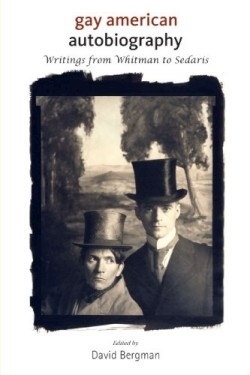Gay American Autobiography
Writings from Whitman to Sedaris
Definition can be a wily beast, and from the outset of this compendium of essays, letters, and journals from gay men, editor David Bergman admits that creating the structure was challenging.
After all, some of the authors in the collection didn’t live “out” as homosexuals, and never wrote about their experiences; also some, like Henry James, may have been born in America but spent most of their lives in other countries. Trickiest of all is the slippery meaning of autobiography, which can take the form of missives to a lover or fictionalized events.
But it’s just this type of fluidity that makes Gay American Autobiography such a powerful and important work, since it demonstrates the range of gay experience over 150 years, and how the writers here worked to create their own definitions, on their own terms. Bergman, a professor of English at Towson State University and the author of several books, notes in his introduction that one common, distinctive thread that gay authors tend to have is their “coming out” story, which heterosexual writers never encounter. (In other words, who has to break it to their parents that they’re straight?)
Although some of the writing in this collection touches on that realization of same-sex desire, there are several smaller, more nuanced themes that resonate throughout. Whether its Walt Whitman writing to his lover, Patrick Doyle, or David Sedaris recalling how his father kicked him out for being gay, the universal themes of isolation, yearning, and passion will touch any reader, gay or straight.
Arranged chronologically, the pieces also create a timeframe of the gradual shift from public outrage to more general acceptance of homosexuality. A particularly joyous example of this pivot is in Arnie Kantrowitz’s selection, an excerpt from his autobiography Under the Rainbow that chronicles his times as a gay activist in the 1970s.
Other selections range from the struggles of a drag queen, Jacques Minette, in the 1950s to a sentimental recollection of growing up in a Hispanic family, penned by Gil Cuadro’s, who died at the age of thirty-four of AIDS-related causes in 1996. In the latter half of the book, AIDS does filter in more strongly, but Bergman chooses to have the disease appear as a specter rather than a focus.
No matter the subject of each piece, there is a vibrancy that resonates and contributes to a cohesive whole. Bergman writes that the aim of the book is to give a glimpse of the various lives gay men have lived, and how they’ve understood their experience, and he meets that goal admirably.
“The stories are horrifying and mundane, hilarious and grim, wistful and insistent,” Bergman notes. “They are anybody’s life because they are like no lives anyone else has ever had.”
Reviewed by
Elizabeth Millard
Disclosure: This article is not an endorsement, but a review. The publisher of this book provided free copies of the book to have their book reviewed by a professional reviewer. No fee was paid by the publisher for this review. Foreword Reviews only recommends books that we love. Foreword Magazine, Inc. is disclosing this in accordance with the Federal Trade Commission’s 16 CFR, Part 255.

